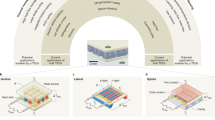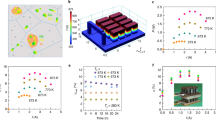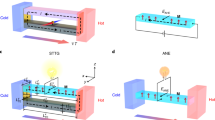Abstract
To date, there are very few technologies available for the conversion of low-temperature waste heat into electricity. Thermomagnetic generators are one approach proposed more than a century ago. Such devices are based on a cyclic change of magnetization with temperature. This switches a magnetic flux and, according to Faraday’s law, induces a voltage. Here we demonstrate that guiding the magnetic flux with an appropriate topology of the magnetic circuit improves the performance of thermomagnetic generators by orders of magnitude. Through a combination of experiments and simulations, we show that a pretzel-like topology results in a sign reversal of the magnetic flux. This avoids the drawbacks of previous designs, namely, magnetic stray fields, hysteresis and complex geometries of the thermomagnetic material. Our demonstrator, which is based on magnetocaloric plates, illustrates that this solid-state energy conversion technology presents a key step towards becoming competitive with thermoelectrics for energy harvesting near room temperature.
This is a preview of subscription content, access via your institution
Access options
Access Nature and 54 other Nature Portfolio journals
Get Nature+, our best-value online-access subscription
$29.99 / 30 days
cancel any time
Subscribe to this journal
Receive 12 digital issues and online access to articles
$119.00 per year
only $9.92 per issue
Buy this article
- Purchase on Springer Link
- Instant access to full article PDF
Prices may be subject to local taxes which are calculated during checkout







Similar content being viewed by others
Data availability
The data sets generated and analysed during the current study are available from the corresponding author upon reasonable request.
References
Schierning, G. Bring on the heat. Nat. Energy 3, 92–93 (2018).
Champier, D. Thermoelectric generators: a review of applications. Energy Convers. Manag. 140, 167–181 (2017).
Tesla, N. Pyromagneto electric generator. US patent 428,057 (1890).
Edison, T. A. Pyromagnetic generator. US patent 476,983 (1892).
Srivastava, V., Song, Y., Bhatti, K. & James, R. D. The direct conversion of heat to electricity using multiferroic alloys. Adv. Energy Mat. 1(1), 97–104 (2011).
Pecharsky, V. K. & Gschneidner, K. A.Jr Giant magnetocaloric effect in Gd5(Si2Ge2). Phys. Rev. Lett. 78, 4494–4497 (1997).
Waske, A., Gruner, M. E., Gottschall, T. & Gutfleisch, O. Magnetocaloric materials for refrigeration near room temperature. MRS. Bull. 43, 269–273 (2018).
Christiaanse, T. & Brück, E. Proof-of-concept static thermomagnetic generator experimental device. Met. Mat. Trans. E 1(1), 36–40 (2014).
Brillouin, L. & Iskenderian, H. P. Thermomagnetic generator. El. Com. 25(3), 300–311 (1948).
Elliott, J. F. Thermomagnetic generator. J. Appl. Phys. 30(11), 1774–1777 (1959).
Kirol, L. D. & Mills, J. I. Numerical analysis of thermomagnetic generators. J. Appl. Phys. 56, 824–828 (1984).
Hsu, C.-J., Sandoval, S. M., Wetzlar, K. P. & Carman, G. P. Thermomagnetic conversion efficiencies for ferromagnetic materials. J. Appl. Phys. 110, 123923 (2011).
Ohkoshi, M., Kobayashi, H., Katayama, T., Hirano, M. & Tsushima, T. A proposal of application of spin reorientation phenomenon to the thermomagnetic power generation. Jpn J. Appl. Phys. 15(10), 2019 (1967).
Brungsberg, H. Vorrichtung zur umwandlung von thermischer in elektrische oder mechanische energie mittels eines magnetischen systems. DE Patent DE 3106520 (1981).
Kazumasa, S. Thermomagnetic power generation apperatus using thermosensitive magnetic substance. J Patent 07107764 A (1995).
Herzig, A., Herzig, K. & Herzig, Y. Vorrichtung und verfahren zur gewinnung elektrischer energie aus wärmeenergie. DE Patent DE 10 2007 023 505 A1 (2007).
Edison, T. A. Pyromagnetic motor. US Patent 380,100 (1888).
Tesla, N. Thermomagnetic motor. US Patent 396,121 (1889).
Kishore, R. A. & Priya, S. A review on design and performance of thermomagnetic devices. Renew. Sustain. Energy Rev. 81, 33–44 (2018).
Swiss Blue Energy AG, Thermo-magnetic motor; www.swiss-blue-energy.ch/en/index.html (accessed 2 March 2018).
Gueltig, M. et al. High-performance thermomagnetic generators based on Heusler alloy films. Adv. Energy Mater. 7, 1601879 (2017).
Chun, J. et al. Thermo-magneto-electric generator arrays for active heat recovery system. Sci. Rep. 7, 41383 (2017).
O’Handley, R. C. Modern Magnetic Materials: Principles and Applications (John Wiley & Sons, New York, 2000).
Advanced Materials—The Key to Progress (VACUUMSCHMELZE, 2015); www.vacuumschmelze.de/fileadmin/Medienbiliothek_2010/Downloads/DM/CALORIVAC-PCV-001_2015.pdf
Kitanovski, A. et al. Magnetocaloric Energy Conversion (Springer, Heidelberg, 2015).
Waske, A. et al. Asymmetric first-order transition and interlocked particle state in magnetocaloric La(Fe,Si)13. Phys. Stat. Sol. RRL 9, 136–140 (2015).
Acknowledgements
We thank S. Grasemann for assistance with the technical realization of the TMG and the technical drawing, A. Chirkova for the photo and U. K. Rößler and M. Kohl for discussions.
Author information
Authors and Affiliations
Contributions
A.W. and S.F. conceived the experiments and wrote the outline of the paper. D.D. characterized the TMG. K.S. proposed the topology with genus = 3 and optimized the design. D.B. conducted most of the finite element calculations. A.S. characterized the thermomagnetic material. K.N. added the discussion on the impact and thermoelectric generators. S.F. wrote the first version of the manuscript, and all the authors contributed to the final version.
Corresponding author
Ethics declarations
Competing interests
K.S., S.F. and A.W. filed a patent (DE patent application no. DE 10 2016 122 274.7) on this topology.
Additional information
Publisher’s note: Springer Nature remains neutral with regard to jurisdictional claims in published maps and institutional affiliations.
Supplementary information
Supplementary Information
Supplementary Figures 1–17, Supplementary Tables 1–2, Supplementary Notes 1–14 and Supplementary References
Rights and permissions
About this article
Cite this article
Waske, A., Dzekan, D., Sellschopp, K. et al. Energy harvesting near room temperature using a thermomagnetic generator with a pretzel-like magnetic flux topology. Nat Energy 4, 68–74 (2019). https://doi.org/10.1038/s41560-018-0306-x
Received:
Accepted:
Published:
Issue Date:
DOI: https://doi.org/10.1038/s41560-018-0306-x
This article is cited by
-
High-performance thermomagnetic generator controlled by a magnetocaloric switch
Nature Communications (2023)
-
Tuning Magnetocaloric Effect in Ternary FeRh-Based Alloys by Slight Doping
Metallurgical and Materials Transactions A (2023)
-
A new twist
Nature Energy (2018)



